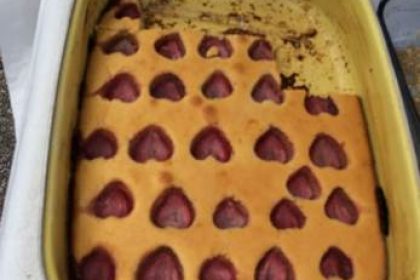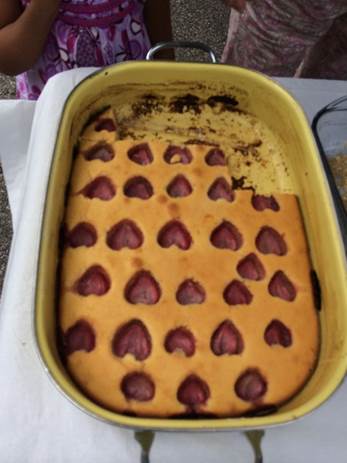
As a Mohegan tribal member, I grew up attending festivals and events that centered around indigenous food, such as the Green Corn Festival, Succotash Time, and summer powwows throughout New England. Many of our traditional stories also relate to food. Tales of Moshup the giant, and his wife, Granny Squannit, the leader of the Little People, emphasize land and sea. This is important because many tribes in New England live along the shoreline, and therefore have the ability to hunt and fish. Granny is known as the keeper of the plants and medicine while Moshup tales relate to the ocean.
As we prepare for Thanksgiving, many Americans are acknowledging the indigenous people of this country, and for most, this is the only time all year they will do so. I acknowledge my Native ancestors every day, giving thanks for the struggles they went through to create a better world for the generations to come.
I also give thanks for the fertile New England soil, and the bounty of foods we are blessed with in this region, from land and sea, such as shellfish, deer, turkey, fiddlehead ferns, and so much more.
In my Mohegan community, as well as that of the Wampanoag, Narragansett, and other New England tribes, rather than one thanksgiving harvest celebration, we have multiple thanksgivings to celebrate the seasonal foods available at each time of year, including Corn Thanksgiving, Maple Sugar Thanksgiving, Strawberry Thanksgiving, Green bean Thanksgiving, and Cranberry Thanksgiving. Each of these “thanksgiving” celebrations includes a feast as well as traditional song, dance, and games.
 Loren Spears, Narragansett Tribal Member and Director of Tomaquag Indian Museum in Exeter, RI states “…You gave thanks for gifts of the season. Those gifts of the season become those things that you felt were most poignant that became the thing to celebrate, like in the case of the Strawberry Thanksgiving. In the Narragansett community it is also considered the gift of friendship, It is one of the first berries of the season that are ready to harvest in the wild.” Many Native peoples in New England still cook traditional recipes with strawberries, such as strawberry drink and Narragansett Strawberry Bread.
Loren Spears, Narragansett Tribal Member and Director of Tomaquag Indian Museum in Exeter, RI states “…You gave thanks for gifts of the season. Those gifts of the season become those things that you felt were most poignant that became the thing to celebrate, like in the case of the Strawberry Thanksgiving. In the Narragansett community it is also considered the gift of friendship, It is one of the first berries of the season that are ready to harvest in the wild.” Many Native peoples in New England still cook traditional recipes with strawberries, such as strawberry drink and Narragansett Strawberry Bread.
While many Natives celebrate Strawberry Thanksgiving, some do not celebrate the American Thanksgiving, because the story of friendship is not exactly true. The Wampanoag people who resided in the Plymouth region were actually not invited to feast. It was a three day meeting to negotiate land, and therefore only Wampanoag warriors were in attendance. Although the story is inaccurate, many Native people in the United States still celebrate the “Thanksgiving” harvest with their families, while others choose to attend a Thanksgiving protest held at Plymouth each year, known as the “National Day of Mourning.”
As you enjoy your Thanksgiving feast this year, please be sure to acknowledge the Native American tribes in this region and, if you’re adventurous, perhaps try out a traditional recipe.
Modern Day Narragansett Strawberry Bread
From Dale Carson’s New Native American Cooking with permission from the author
(Serves 9)
½ cup butter
¾ cup maple sugar
1 egg
2 cups all-purpose flour
½ cup cornmeal
½ cup finely ground walnuts
1 teaspoon baking powder
½ teaspoon salt
milk enough to make a stiff batter
1 cup wild strawberries, rinsed and stemmed, or cultivated strawberries, rinsed, stemmed, and quartered
- Preheat oven to 350° F
- In a mixing bowl, cream butter and sugar. Add the egg and beat until smooth.
- Add flour, nuts, baking powder, and salt. Stir and add milk enough to make a stiff batter
- Gently fold in the strawberries and turn batter into an eight or 9 inch square baking pan.
- Bake in the center of the oven for 20 to 25 minutes or until a knife inserted in the center of the bread comes out clean.
- Let cool before slicing.
Rachel Sayet, Mohegan, holds a B.S. from Cornell University and an MA in anthropology at Harvard University. Her master’s thesis focused on traditional stories of the Mohegan and Wampanoag tribes.
Rachel currently works for the Mohegan Library, organizing events with Native authors, running a weekly storytime, and promoting indigenous food.
For more information on Native American food, feel free to contact Rachel at rbsayet “at” gmail.com or join her Facebook and tumblr pages @“Uni will never be bacon”




